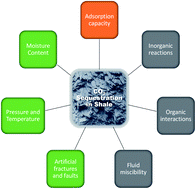Geochemical controls on CO2 interactions with deep subsurface shales: implications for geologic carbon sequestration†
Abstract
One of the primary drivers of global warming is the exponential increase in CO2 emissions. According to IPCC, if the CO2 emissions continue to increase at the current rate, global warming is likely to increase by 1.5 °C, above pre-industrial levels, between the years 2030 and 2052. Efficient and sustainable geologic CO2 sequestration (GCS) offers one plausible solution for reducing CO2 levels. The impermeable shale formations have traditionally served as good seals for reservoirs in which CO2 has been injected for GCS. The rapid development of subsurface organic-rich shales for hydrocarbon recovery has opened up the possibility of utilizing these hydraulically fractured shale reservoirs as potential target reservoirs for GCS. However, to evaluate the GCS potential of different types of shales, we need to better understand the geochemical reactions at CO2–fluid–shale interfaces and how they affect the flow and CO2 storage permanence. In this review, we discuss the current state of knowledge on the interactions of CO2 with shale fluids, minerals, and organic matter, and the impact of parameters such as pressure, temperature, and moisture content on these interactions. We also discuss the potential of using CO2 as an alternate fracturing fluid, its role in enhanced shale gas recovery, and different geochemical tracers to identify whether CO2 or brine migration occurred along a particular fluid transport pathway. Additionally, this review highlights the need for future studies to focus on determining (1) the contribution of CO2 solubility and the impact of formation water chemistry on GCS, (2) the rates of dissolution/precipitation and sorption reactions, (3) the role of mineralogical and structural heterogeneities in shale, (4) differences in reaction mechanisms/rates between gaseous CO2vs. brine mixed CO2vs. supercritical CO2, (5) the use of CO2 as a fracturing fluid and its proppant carrying capacity and (6) the role of CO2 in enhanced hydrocarbon recovery.

- This article is part of the themed collection: SDG13: Climate Action- chemistry of greenhouse gases, 2022


 Please wait while we load your content...
Please wait while we load your content...